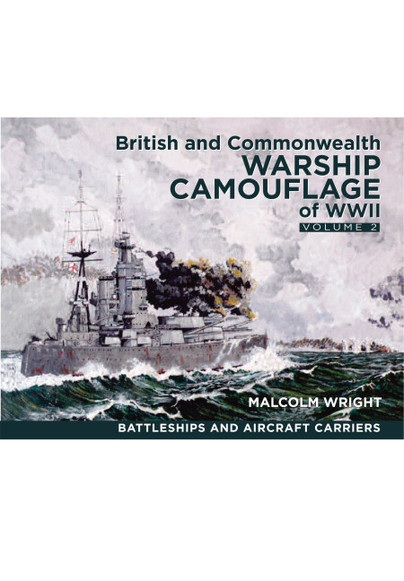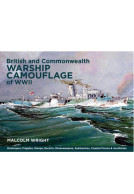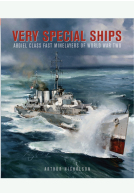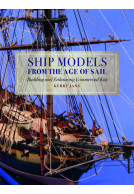British and Commonwealth Warship Camouflage of WW II: Vol 2 (Paperback)
Battleships & Aircraft Carriers

Pages: 192
Illustrations: 525 colour profiles
ISBN: 9781399024877
Published: 21st August 2023
Youtube!
Bruships 87: Books Found on My Travels, New Books & Christmas Recomendations - YouTube
Dr Alexander Clarke Does Naval History Live - Skip to 1:20:41
(click here for international delivery rates)
Order within the next 1 hour, 54 minutes to get your order processed the next working day!
Need a currency converter? Check XE.com for live rates
| Other formats available | Price |
|---|---|
| British and Commonwealth Warship… ePub (143.1 MB) Add to Basket | £12.00 |
During the Second World War navies developed low visibility camouflage for their ships, on both the vertical and horizontal surfaces, in order reduce visibility by blending in with the sea, or confuse the identity of a ship by applying more obtrusive patters. In this the second volume by maritime artist Mal Wright, both the official and unofficial paint schemes that adorned the capital ships of the Royal Navy and Commonwealth are depicted in detail, along with discussions on changes of armament and electronics that effected the outward appearance of each ship.
Beginning with the Royal Sovereign class, the book goes on to cover all the other battleship classes as well as the battlecruisers, monitors, the first and second generation carriers as well as light and escort carriers. Where possible both sides of the ship are depicted, and there are multiple images of the ships where armament or equipment changes had a fundamental impact on a ship's appearance. Overhead views are also included. With 525 full colour illustrations, arranged by ship type rather than camouflage scheme, this book concentrates the clearest possible information into a single volume to provide a one-stop reference source.
Many schemes would be difficult for the reader to have found other than with the most intensive research so that historians, collectors, modelmakers and wargamers will find this unique reference source absolutely invaluable.
“A wonderful collection, you will spend hours poring through, looking at the detailed pictures……Very resourceful and fun reads”.
Bruships
Watch here at 02:39:00
"All in all a fascinating beautifully illustrated three Volume set."
The Society of Model and Experimental Engineers
This book and its companion volumes will be of
Warship 2017, reviewed by Andy Field
interest to wargamers, modellers and other enthusiasts.
As featured in
STORIA MILITARE, February 2017
Both volumes (referring to volumes 2 & 3) are extremely equipped lavishly with a huge number of drawings and an absolute must for everyone.
ModellWerft, March 2017
There's a wealth of inspiration here for any naval fan, and the colours and patterns are often highly attractive...and beg to be reproduced in scale form.
Airfix Model World, March 2017
This lavishly illustrated book naturally carries a higher cover price because of the cost of illustration and production, but it is well worth it. There is appropriate text in the form of introductions and extended captions. Very highly recommended.
Firetrench
Read the full review here!
This makes a great addition to your references if you are a ship modeller in particular, as so many of these are available in kit form these days, as well as being interesting to those who like to study the subject of camouflage. Another excellent reference book.
Military Modelling Magazine May 2016
Mal Wright is an Australian maritime artist, naval gamer and student of history who has compiled a large collection of colour illustrations of British naval camouflage, which will be a benefit to historians, modellers and gamers. Volume 2 covers battleships, monitors and aircraft carriers.
SITREP, April 2016 - Ed Kettler
Volume 2 covers fewer ships over a broader time period, and typically each ships entry provides both port and starboard views, and many have deck views. When aircraft are carried, they are noted with a standard graphic, including kite balloons. The entries in some cases go back to their service in the Great War, then progress throughout their wartime career, and explain the changes in the camouflage and the intent of the new scheme.
These books are invaluable sources for the modeller, gamer and historian. While many of these designs have been documented previously, this is the largest collected work on British and Commonwealth camouflage, and probably the most cost effective way to obtain the material, as many of the sources Mal cites are long out of print. These volumes should be considered for your naval reference library not only for their colour schemes, but also for the ship histories.
This book shows you warships at war. 4.5 out of 5 from me.
ARRSE - Seaweed
With 525 full colour illustrations, all of named vessels, this book concentrates an astonishing level of information regarding paint colours, schemes and patterns into a single volume to provide a unique one-stop reference source.
Model Boats magazine, May 2016 - John Deamer
Many paint schemes would be difficult for any reader to unearth other than with the most intensive research, which may after all the intervening years prove to be impossible. This is surely the most invaluable tool for ship modellers, naval historians, collectors and wargamers alike.
A book that fills a valid place in the wartime naval history.
Scuttlebutt edition 52
Amazing, wonderful and indispensable for both historians and for modellers or naval wargame players .
José Manuél Rico Cortés (Mister JM) - Miniaturas JM
The book represents an excellent reference work, offering invaluable colour profiles for researchers, model makers and artists alike. It is also good to browse for the sheer enjoyment of Wright's book.
Warships International Fleet Review
As featured in
Marine Model Magazine Jan 2016
Until now my main reference for WWII British Warship camouflage has been the series of paperback publications, 'Warship Perspectives' by Alan Raven, but this new volume by Malcolm Wright has blown them out of the water.
Dreadnought, Battleship Special Interest Group
I think this book is a must for the serious modeller, collector and historian.
As featured on.
MSC Review Connect
Malcolm Wright, and accomplished artist and author, presents us with a second part in a short series on warship camouflage; his first being Volume 1, British and Commonwealth Warship Camouflage of WWII Destroyers, Frigates, Sloops, Escorts, Minesweepers, Submarines, Coastal Forces and Auxiliaries. This time the author gives us a hardcover, 191 page detailed look at the various color schemes used by the British on their capital ships during WWII...
Model Shipwrights
... Malcolm Wright has made an exhaustive effort to accurately represent all colour schemes shown in this book. Through his in-depth research from archival records as well as from speaking with the men who served on these ships the representation of camouflage schemes shown is as close as it gets to date. This book is certainly geared to the model shipwright, however, any British Naval history enthusiast will more than benefit from the information contained within. There are seventy-six ships covered in this book which constitutes the bulk of the capitol ships afloat for the British and Commonwealth. In many cases, the author has listed alternatives to the camouflage schemes covering different time periods of the ship's service. There are some missing carriers excluded from the book, however, unless you were looking specifically for these, you should have everything one might need for referencing WWII British and Commonwealth naval subjects in modelling.
I highly recommend Malcolm Wright’s British and Commonwealth Warship Camouflage of WWII – Volume 2 – Battleships and Aircraft Carriers to anyone looking for specific camouflage schemes for their model building purposes as this is a valuable resource for any modeller's library!!
In accord with the first volume in the series, which covered destroyers, minesweepers and other smaller crafts of Royal and Commonwealth Navy, this volume covers battleships, aircraft carriers, escort carriers and monitors. The book contains more than 500 color illustrations. Besides that, the book has explanations of all the modifications and alterations of weaponry as well as other equipment that might change the appearance of the ship during its career. The amount of information collected in the book is an absolute treasure for the naval history afficionados, especially those interested in the WWII period. There are several reproductions of the paintings throughout the book, painted by the author as well. Besides history lovers, this reference book will be invaluable to collectors, wargamers and modelmakers as well, especially to the latter ones.
Novi Sad Magazine
The book covers battleships, battlecruisers, monitors, first and second generation of carriers, as well as escort carriers, with both sides of the ship and birds-eye view shown where possible. Many of the schemes depicted here would require a huge amount of serious research by the reader in order to find them. Therefore the book is quite an important reference source for all interested in naval history.
As a conclusion, this book is a must have for all ship modelmakers, wargamers, as well as anyone interested in this historical periood and navy in general.
This is the second volume in a series by Australian author Malcolm Wright who has spent 50 years researching the camouflage schemes worn by British and Commonwealth warships during World War II.
Australian Naval Institute - David Hobbs
British and Commonwealth Warship Camouflage of World War II contains no less than 525 colour illustrations showing every battleship, battlecruiser, aircraft carrier, seaplane carrier and monitor. In his introduction Mal Wright explains how he researched his subject using drawings and photographs as well as interviewing veterans and dockyard workers.
He also makes the valid point that no matter how carefully a paint scheme might be studied, modern art work will never, quite, be able to match the original because of fading, salt corrosion and the ‘that looks about right’ mixing process employed by most sailors who carried out the work. While his tones may not, therefore, exactly replicate those on the original ship on a given day under cloud or sunlight, the patterns are accurate and the author can fairly claim to have produced the definitive work on the subject to date.
Many of the drawings show both sides of a ship and some an overhead view. Like Volume 1, this book provides an affordable reference work that shows how Commonwealth warships would have looked at sea, give or take the odd rust streak and faded patch. The drawings are not to a constant scale but are reproduced to fill the page; aircraft symbols are included to show the various different types that were embarked in individual ships.
As well as the drawings, the author has included technical details of the ships’ armament and radar fits as well as brief notes on their operational service and eventual fates, making this a handy reference source for a wide variety of readers.
Overall, this is a very good book that brings the subject matter to life in a way that no previous work has done. Like its predecessor you can read it from cover to cover or dip into it to study a particular ship or class and it is a tribute both to Mal Wright’s many years of research and his artwork. I thoroughly recommend it and was pleased to learn that a third volume covering cruisers is in preparation.
Malcolm Wright is an Australian maritime artist and wargame designer and this is the second volume in this set taken from his research over some 50 years of interest and a series of wargame book illustrations.
Military Modelling Online
This one starts off with an introduction that provides background in which the author explains his interests along with notes on how he has collected the information over the years, he then adds a list of his reference resources along with background notes on the Paint Types and Schemes. Then a handy paint colour chart and explanation of the aircraft type illustrations and weapons/electronic systems used in the illustrations.
Then we get to the meat of the book, with 5 sections that give the colour artwork for WW1 Era Battleships and Battlecruisers (which were still in service in WW2): then Modern Battleships: Monitors: Aircraft Carriers: and finally Escort Carriers. The colour profiles (and some with top views as well) show how changes in equipment armament and radars in particular) altered the profile of a ship during its service life, and the number of different camouflage patterns that were applied to them as well. So many ships have four or five quite different colour schemes applied and they are each illustrated individually. Just for an example, the Royal Sovereign has 4 different colour schemes plus two more while she served the Russian Navy as the Archangelsk. A sister ship, the Ramilles has as many as 8 different schemes while in Royal Navy Service. In the final section, with Fleet carriers and then Escort Carriers, many have views from both sides so you see how the pattern differed from port and starboard sides, and also the pattern applied to the flight decks, some of which were quite elaborate.
This makes a great addition to your references if you are a ship modeller in particular, as so many of these are available in kit form these days, as well as being interesting to those who like to study the subject of camouflage. Interesting that when you see close up they look quite extreme in some cases, but when seen at the ranges experienced at sea, how these patterns would have broken up the outline and appearance of a ship to an enemy observer, perhaps enough that they come within range of attack before they can take avoiding action. Another excellent reference.
Will appeal to a wide audience
Ships Monthly
This book concentrates the clearest possible information into a single volume to provide a one-stop reference source.
Warship World
About Malcolm George Wright
MAL WRIGHT is an Australian maritime artist who is also an internationally-known wargames designer and writer and lecturuer. He has spent five decades researching this volume, making notes while interviewing veterans, as well as consulting official sources, photographs and the work of artists of the era. He lives in Adelaide and is currently working on a second volume covering capital ships.


















